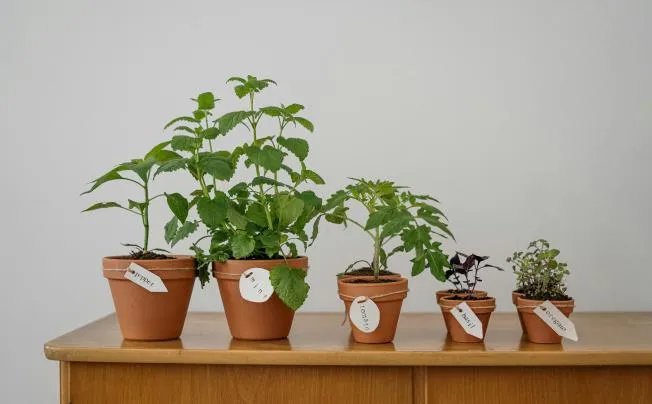Do Galvanized Planters Get Too Hot?
Will galvanized flower pots get too hot in the summer? This question not only affects whether our beloved plants can thrive in the summer, but also affects our decision-making when choosing flower pots.
How to judge whether the temperature of galvanized flower pots is too high?
(I) Assess the condition of the plants
Because the chlorophyll in the leaves can do photosynthesis and function normally, the leaves of plants are often emerald green and vibrant. However, if the flowerpot's temperature is too high, the synthesis of chlorophyll will be suppressed and the pace of decomposition will be accelerated. This will lead to a decrease in the amount of chlorophyll in the leaves, which will cause them to gradually lose their green hue and turn yellow.
A high temperature will cause plants to transpire more quickly and lose a lot of water through the stomata on the leaf surface. The plants will run out of water when the flowerpot's temperature rises too high and the soil's water supply isn't refilled in time, causing the leaves to progressively wither. Only the edges of the leaves may initially start to dry out. The entire leaf will dry out, curl, and eventually fall off as the temperature rises further and the water deficit gets worse.
Plants can perform regular metabolism, growth, and development at the right temperature, and they grow quickly because cell division and elongation are accelerated. However, if the flowerpot's temperature is too high, the plant's physiological activities will be inhibited, and crucial physiological processes like respiration and photosynthesis will be impacted. As a result, the plant won't be able to get enough energy and substances to support growth, which will drastically slow down the rate of growth. In an environment with high temperatures, seedlings that should have developed quickly might not mature for a long time, and the germination of new leaves will also slow down.
High temperatures can also cause the plant to lose its fruits and blossoms in addition to the symptoms listed above. High temperatures can have an impact on pollen viability, pollination, and fertilisation processes for certain flowering and fruiting plants. This can prevent flowers from being pollinated or immature fruits from developing healthily, which can lead to falling flowers and fruits. Furthermore, the plant's leaves may curl and burn, both of which are signs of high temperatures harming the plant.

(II) Measure using a thermometer
There are numerous varieties of thermometers available. Common mercury thermometers provide a good degree of measurement accuracy and are reasonably priced. However, mercury is poisonous, and mercury thermometers are brittle and easily broken. They will damage the environment and human health if they are inadvertently broken.
Easy reading and quick measurement speed are two benefits of using an electronic thermometer. It uses sensors to detect temperature changes and shows the digital temperature readings on the screen, which are easily readable at a glance. Convenient features like tracking temperature changes and setting temperature alarms are also included in some electronic thermometers.
Infrared thermometers are relatively easy to use and can detect temperature without coming into contact with anything. To rapidly determine the temperature of the galvanized flower pot's surface, simply aim the infrared thermometer at it and push the measuring button. This thermometer works especially well for checking the temperature of items that are hard to reach, like flower pots that are left out in the sun.
You must be mindful of the proper measurement technique when using a thermometer. In order to measure the temperature of the soil in the flowerpot using a mercury thermometer or an electronic thermometer, you should bury the probe of the thermometer in the soil, usually 5 to 10 cm deep. This will allow you to measure the temperature inside the soil and more accurately reflect the temperature of the area where the plant roots are located. To prevent injuring the plant's roots, take care not to contact them when inserting the probe. To prevent injuring the plant's roots, take care not to contact them when inserting the probe. To determine the flowerpot's surface temperature, gently place the thermometer's probe against the flowerpot's surface and wait for the reading to stabilize before taking a reading.
The typical temperature range that most plants can grow in is between 15°C and 25°C. The plant's many physiological functions can all run smoothly within this temperature range, and processes like photosynthesis, respiration, and water metabolism may all work together harmoniously, supporting the plant's growth and development. The growth of the plant may be negatively impacted if the temperature in the galvanized flowerpot rises beyond 30°C; if it keeps rising above 35°C, the plant may suffer significant harm or maybe die.

How to solve the problem of galvanized flower pots being too hot?
1. Modify the location
To avoid direct sunlight, which might lower the flower pot's temperature due to the angle of light, move it to a cool location. The flower pot's temperature will naturally drop if it is placed on the building's shaded side, where the sun cannot beam directly.
Another wise option is to use a sunshade net. The sunshade net's shading level can be changed to suit individual needs. In general, selecting a sunshade net with a 50% to 70% shading rate is more appropriate. To keep the sunshade net at a specific distance from the flower pot, cover it above it and use a bracket to support it. This may guarantee air circulation and efficiently block sunlight. Be careful to secure the sunshade net when using it to prevent wind from blowing it away.
2. Strengthen ventilation protocols
By positioning the flower pot in an area with adequate ventilation, the heat surrounding the pot can be dissipated and air can flow freely.
Fans and other devices can be used to improve air circulation if the natural ventilation conditions are poor. The fan's speed can be changed based on the circumstances. In most cases, the low speed gear can satisfy the requirements. To prevent excessive wind damage to the plants, use caution when positioning a fan too close to the flower pot. To enhance the heat dissipation effect, you can also rotate the flower pot on a regular basis so that the wind blows on all sides of the pot.

Selected Blogs
-
What customization services are available for metalworking customization?
2024-12-12
-
What Is The Difference Between A Plant Container And A Raised Bed?
2024-04-23
-
Garden Screening & Fence Panels
2024-04-23
-
Gardening pot selection tips
2024-04-17
-
The function and collocation of horticultural fire pot
2024-04-17


